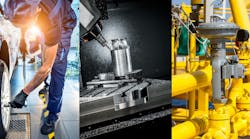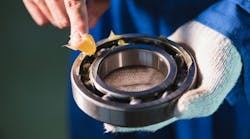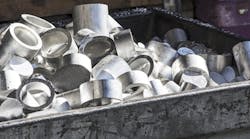Q: We forge steel, primarily, but are forging some aluminum alloys now, and finding some defects we cannot define because they seem to occur after the forgings are machined and coated. Do you have information about forging defects in aluminum forgings?
A: Some forms of de-laminations in low-alloy aluminum are traceable to hydrogen pickup (blisters), extra large grain size, casting defects, and surface-to-center "smearing" (where lubricant can cause more rapid metal flow than center.) The last problem may occur in hammer forging but is unlikely in press forgings.
You need to evaluate which of these conditions and others might be a source of the problems.
Do you etch-clean before shipment? Because the machined forgings are coated after machining, I assume that you do not coat the forgings with anything, or that are you treating with Alodine or similar for storage purposes? What is the final coating?
Here is a starting list of defects and their sources in aluminum forgings:
- Atmosphere blisters (furnace heating): caused by exposure to combustion byproducts (usually white under blisters).
- Oil/lube blisters: caused by metal flow variations between surface and center material (usually black or dark grey under blisters).
- Flow-through defects: metal flow from centrally located details, and flowing beneath surrounding bosses or ribs. Preform design is a key here.
- Extra large grains after heat treatment: may be from inadequate reductions prior to solution heat treatment, (eg., coining with light reductions.)
For more than 40 years H. James Henning held key technical positions in the forging industry, including as director of technology for the Forging Industry Association, and as president of Henning Education Services, a Columbus, OH, firm specializing in customized education and training in forging technologies.
Guidelines and recommendations offered in this column are based on information believed to be reliable and are supplied in good faith but without guarantee. Operational conditions that exist in individual plants and facilities vary widely. Users of this information should adapt it, and always exercise independent discretion in establishing plant or facility operating practices.













